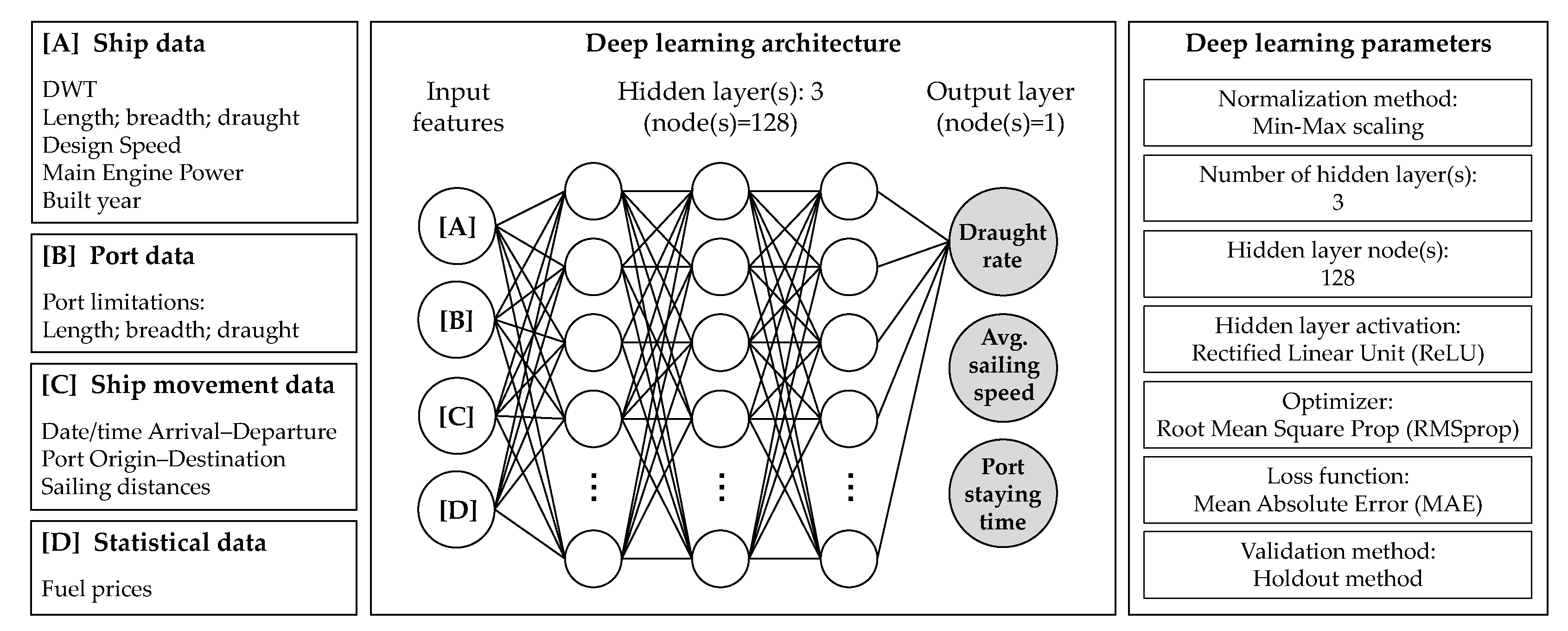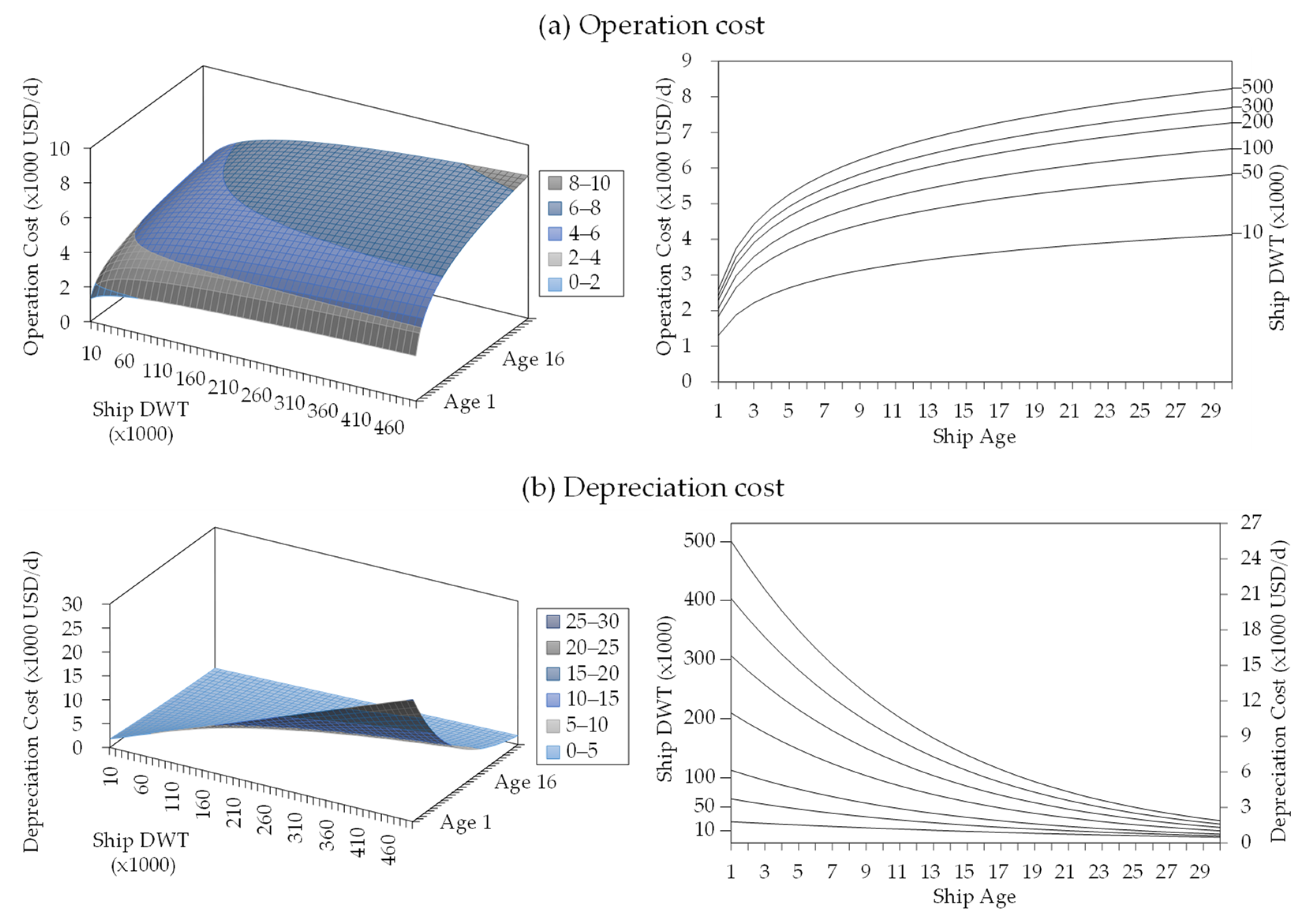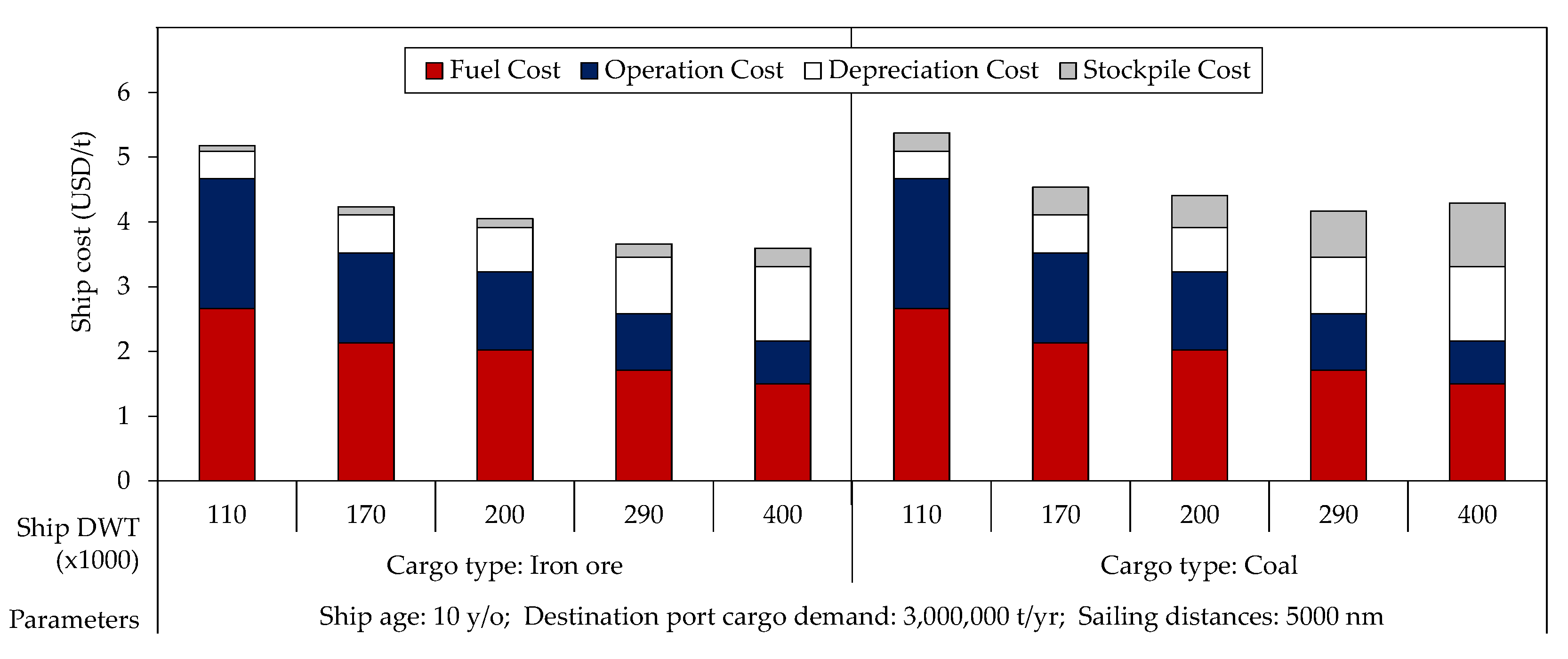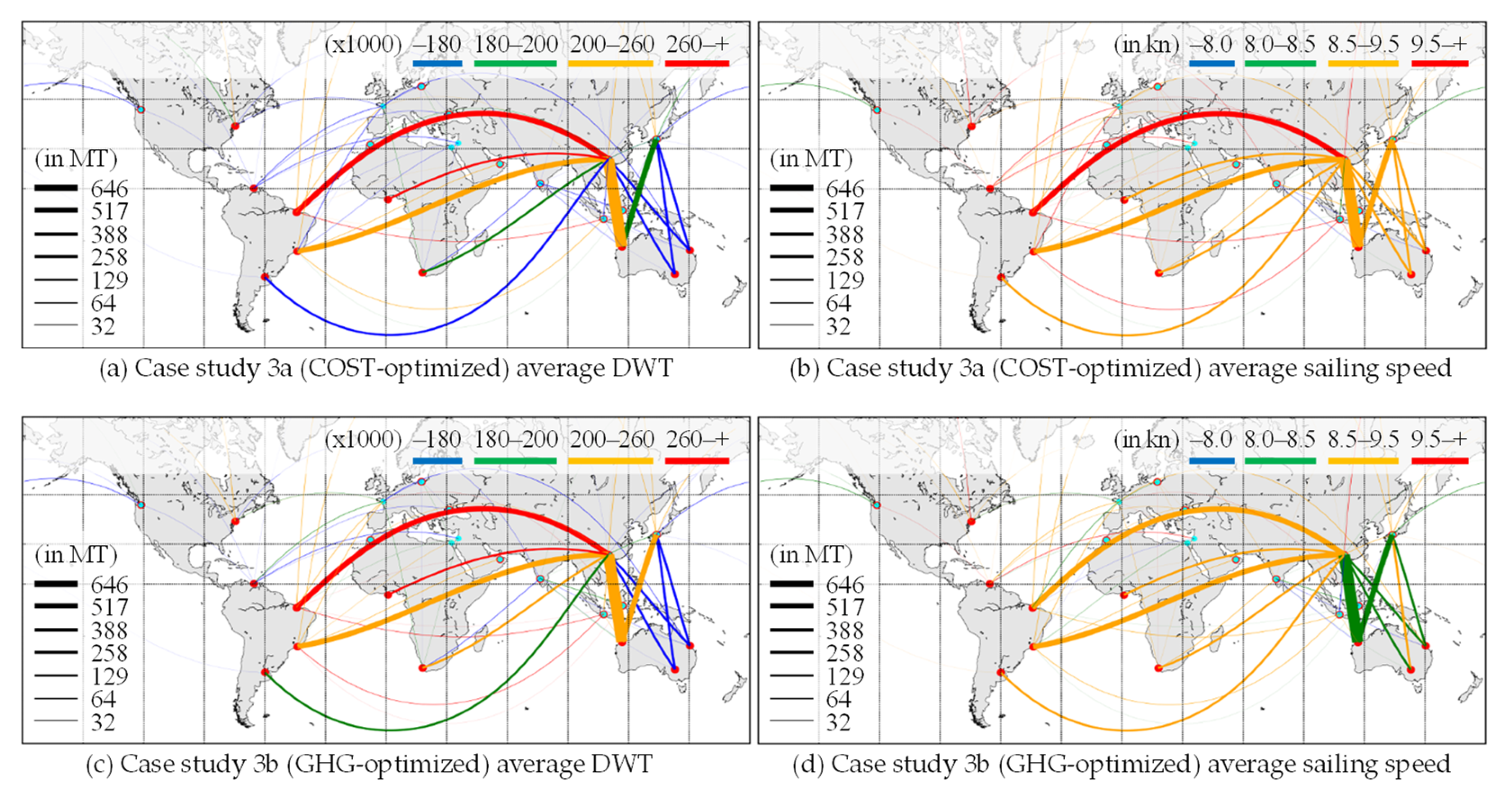Basic Ship-Planning Support System Using Big Data in Maritime Logistics for Simulating Demand Generation
Abstract
1. Introduction
2. Literature Review
2.1. Related Studies Utilizing Big Data in Maritime Logistics
2.2. Optimization Studies in Ship Deployment and Contracts
2.3. Originalities in This Study
- Target route and cargo type: Prior simulations [30] were executed on limited target routes and cargo types, such as the Australia, Brazil, Japan, and South Korea routes of iron ore. In contrast, this study has broadened the scope of simulations to accommodate iron ore and coal routes worldwide.
- Ship allocation algorithm: The key performance index (KPI) in the prior ship allocation algorithm [30] considered only the fuel cost as the COST variable. Therefore, the previously generated ship allocation simulation directly reflected the estimated fuel cost, which was a fraction of the actual COST. In this context, this study has proposed more realistic COST attributes [1], such as the costs of fuel, operation, depreciation, and stockpiling.
3. Basic Concept
3.1. Data Used in This Study
3.1.1. Ship Movement Data
3.1.2. Ship Data
3.1.3. Port Data
3.1.4. Route Data
3.2. System Configuration
3.2.1. Global Network Model
3.2.2. Cargo Movement Model
3.2.3. Ship Model
3.2.4. Ship Allocation Algorithm
4. Model Development
4.1. Global Network Model
4.2. Cargo Movement Model
4.3. Ship Model
4.3.1. Ship Specifications
- Principal particulars: Length, breadth, and draught (m);
- Performance: Main engine power (kW) and design speed (kn);
- Administration: Shipbuilder, registered owner, manager, and operator.
4.3.2. Operation Condition Prediction
- Draught rate: The ratio between the arrival draught and the ship’s design draught at the destination port;
- Average sailing speed: The ship’s average sailing speed starting from its departure time at the origin port to its arrival time at the destination port;
- Port staying time: The ship’s port staying time starting from its arrival time until its departure time at the destination port.
5. GHG and COST Calculations
5.1. GHG Calculation
5.2. COST Calculation
5.2.1. Fuel Cost Calculation
5.2.2. Operation Cost and Depreciation Cost Calculations
- Daily operation cost of Capesize bulk carriers [1].
- Operation cost ratios of various bulk carrier size categories in 2011; Capesize, Panamax, Handymax, and Handysize [45].
- Ship DWT range for various bulk carrier size categories in 2011; Capesize, Panamax, Handymax, and Handysize [46].
- Average ship DWT for various bulk carrier size categories in 2011; Capesize (205,000 DWT), Panamax (76,000 DWT), Handymax (51,000 DWT), and Handysize (27,000 DWT) [29].
5.2.3. Stockpile Cost Calculation
5.2.4. Total COST Calculation
5.3. Evaluation of GHG and COST Calculation
6. Ship Allocation Algorithm
6.1. Algorithm 1: Ship Replacement while Preserving the Existing Ship Allocation
6.2. Algorithm 2: An Optimization for Reconstructing Ship Allocation
7. Case Studies and Discussions
- Target ship: Capesize dry bulk carrier (DWT 100,000 or more, 1647 ships);
- Cargo types: Iron ore and coal;
- Route: Worldwide (sailing routes served by target ship);
- Operation period: 2018;
- Assumed fuel prices: 300 USD (HFO, ) and 600 USD (MDO, ).
7.1. Actual Ship Allocation
7.2. Case Study 1: Ship Replacement while Preserving the Existing Ship Allocation
7.2.1. Definition of Case Study 1
- Method: Allocation algorithm 1;
- Offered ships: A new ship for each existing ship in the actual ship allocation.
7.2.2. Results of Case Study 1
7.3. Case Study 2: Ship Allocation Optimization Using Existing Ships
7.3.1. Definition of Case Study 2
- Method: Allocation algorithm 2;
- Offered ships: The existing ships operated in the current ship allocation.
7.3.2. Results of Case Study 2
7.4. Case Study 3: Ship Allocation Simulation with New Ships Instance
7.4.1. Definition of Case Study 3
- Method: Allocation algorithm 2;
- Offered ships: The existing ships of case study 2 and new ships.
7.4.2. Results of Case Study 3
7.5. Discussion 1: Significance of the Total COST and GHG Emissions Reductions
7.6. Discussion 2: New Ship Demand
8. Concluding Remarks
Author Contributions
Funding
Institutional Review Board Statement
Informed Consent Statement
Data Availability Statement
Conflicts of Interest
References
- Stopford, M. Maritime Economics 3e; Routledge: Oxford, UK; New York, NY, USA, 2008. [Google Scholar]
- Fan, J.; Han, F.; Liu, H. Challenges of Big Data analysis. Natl. Sci. Rev. 2014, 1, 293–314. [Google Scholar] [CrossRef] [PubMed]
- Alharthi, A.; Krotov, V.; Bowman, M. Addressing barriers to big data. Bus. Horiz. 2017, 60, 285–292. [Google Scholar] [CrossRef]
- Saggi, M.K.; Jain, S. A survey towards an integration of big data analytics to big insights for value-creation. Inf. Process. Manag. 2018, 54, 758–790. [Google Scholar] [CrossRef]
- IMO. AIS Transponders. Available online: https://www.imo.org/en/OurWork/Safety/Pages/AIS.aspx (accessed on 28 September 2021).
- Svanberg, M.; Santén, V.; Hörteborn, A.; Holm, H.; Finnsgård, C. AIS in maritime research. Mar. Policy 2019, 106, 103520. [Google Scholar] [CrossRef]
- Bauk, S. A Review of NAVDAT and VDES as Upgrades of Maritime Communication Systems. Adv. Mar. Navig. Saf. Sea Transp. 2019, 13, 81–82. [Google Scholar] [CrossRef]
- IMO. Voyage Data Recorders. Available online: https://www.imo.org/en/OurWork/Safety/Pages/VDR.aspx (accessed on 28 September 2021).
- Munim, Z.H.; Dushenko, M.; Jimenez, V.J.; Shakil, M.H.; Imset, M. Big data and artificial intelligence in the maritime industry: A bibliometric review and future research directions. Marit. Policy Manag. 2020, 47, 577–597. [Google Scholar] [CrossRef]
- Mirović, M.; Miličević, M.; Obradović, I. Big data in the maritime industry. NAŠE MORE Znan. Časopis Za More I Pomor. 2018, 65, 56–62. [Google Scholar]
- Zaman, I.; Pazouki, K.; Norman, R.; Younessi, S.; Coleman, S. Challenges and Opportunities of Big Data Analytics for Upcoming Regulations and Future Transformation of the Shipping Industry. Procedia Eng. 2017, 194, 537–544. [Google Scholar] [CrossRef]
- Sanchez-Gonzalez, P.-L.; Díaz-Gutiérrez, D.; Leo, T.J.; Núñez-Rivas, L.R. Toward Digitalization of Maritime Transport? Sensors 2019, 19, 926. [Google Scholar] [CrossRef]
- Yang, C.-H.; Chang, P.-Y. Forecasting the Demand for Container Throughput Using a Mixed-Precision Neural Architecture Based on CNN–LSTM. Mathematics 2020, 8, 1784. [Google Scholar] [CrossRef]
- Jugović, A.; Komadina, N.; Hadžić, A.P. Factors influencing the formation of freight rates on maritime shipping markets. Pomorstvo 2015, 29, 23–29. [Google Scholar]
- Akar, O.; Esmer, S. Cargo Demand Analysis of Container Terminals in Turkey. J. ETA Marit. Sci. 2015, 3, 117–122. [Google Scholar] [CrossRef]
- Gökkuş, Ü.; Yıldırım, M.S.; Aydin, M.M. Estimation of Container Traffic at Seaports by Using Several Soft Computing Methods: A Case of Turkish Seaports. Discret. Dyn. Nat. Soc. 2017, 2017, 2984853. [Google Scholar] [CrossRef]
- Jia, H.; Prakash, V.; Smith, T. Estimating vessel payloads in bulk shipping using AIS data. Int. J. Shipp. Transp. Logist. 2019, 11, 25–40. [Google Scholar] [CrossRef]
- Zhou, X.; Hu, Q. Estimation of Shipment Size in Seaborne Iron Ore Trade. TransNav Int. J. Mar. Navig. Saf. Sea Transp. 2019, 13, 791–796. [Google Scholar] [CrossRef]
- Kanamoto, K.; Murong, L.; Nakashima, M.; Shibasaki, R. Can maritime big data be applied to shipping industry analysis? Focussing on commodities and vessel sizes of dry bulk carriers. Marit. Econ. Logist. 2021, 23, 211–236. [Google Scholar] [CrossRef]
- Prochazka, V.; Adland, R.; Wolff, F.-C. Contracting decisions in the crude oil transportation market: Evidence from fixtures matched with AIS data. Transp. Res. Part A Policy Pract. 2019, 130, 37–53. [Google Scholar] [CrossRef]
- Sharma, R.; Sha, O.P. Development of an Integrated Market Forecasting Model for Shipping and Shipbuilding Parameters. In Proceedings of the RINA–International Conference on Computer Applications in Shipbuilding, Portsmouth, UK, 18–20 September 2007; pp. 18–20. [Google Scholar]
- Wada, Y.; Yamamura, T.; Hamada, K.; Wanaka, S. Evaluation of GHG Emission Measures Based on Shipping and Shipbuilding Market Forecasting. Sustainability 2021, 13, 2760. [Google Scholar] [CrossRef]
- Wada, Y.; Hamada, K.; Hirata, N. Shipbuilding capacity optimization using shipbuilding demand forecasting model. J. Mar. Sci. Technol. 2021, 1–19. [Google Scholar] [CrossRef]
- Wada, Y.; Hamada, K.; Hirata, N.; Seki, K.; Yamada, S. A system dynamics model for shipbuilding demand forecasting. J. Mar. Sci. Technol. 2018, 23, 236–252. [Google Scholar] [CrossRef]
- Lee, S.; Jung, I. Development of a Platform Using Big Data-Based Artificial Intelligence to Predict New Demand of Shipbuilding. J. Inst. Internet Broadcasting Commun. 2019, 19, 171–178. [Google Scholar]
- Fujikubo, M. Digital Twin for Ship Structures: Research Project in Japan (Plenary Lecture Presentation). In Proceedings of the 14th International Symposium on Practical Design of Ships and Other Floating Structures, Yokohama, Japan, 22–20 September 2019. [Google Scholar]
- Breinholt, C.; Ehrke, K.-C.; Papanikolaou, A.; Sames, P.C.; Skjong, R.; Strang, T.; Vassalos, D.; Witolla, T. SAFEDOR–The Implementation of Risk-based Ship Design and Approval. Procedia Soc. Behav. Sci. 2012, 48, 753–764. [Google Scholar] [CrossRef][Green Version]
- Faber, J.; Hanayama, S.; Zhang, S.; Pereda, P.; Comer, B.; Hauerhof, E.; Yuan, H. Fourth IMO Greenhouse Gas Study. Available online: https://docs.imo.org (accessed on 28 September 2021).
- Smith, T.W.P.; Jalkanen, J.P.; Anderson, B.A.; Corbett, J.J.; Faber, J.; Hanayama, S.; O’keeffe, E.; Parker, S.; Johanasson, L.; Aldous, L.; et al. Third IMO Green House Gas study 2014; International Maritime Organization: London, UK, 2015. [Google Scholar]
- Arifin, M.D.; Hamada, K.; Hirata, N.; Ihara, K.; Koide, Y. Development of Ship Allocation Models using Marine Logistics Data and its Application to Bulk Carrier Demand Forecasting and Basic Planning Support. J. Jpn. Soc. Nav. Arch. Ocean Eng. 2018, 27, 139–148. [Google Scholar] [CrossRef]
- Sirimanne, S.N.; Hoffman, J.; Juan, W.; Asariotis, R.; Assaf, M.; Ayala, G.; Benamara, H.; Chantrel, D.; Hoffmann, J.; Premti, A. Review of maritime transport 2019. In Proceedings of the United Nations Conference on Trade and Development, Geneva, Switzerland, 31 January 2020. [Google Scholar]
- Zhang, X.; Lam, J.S.L.; Iris, Ç. Cold chain shipping mode choice with environmental and financial perspectives. Transp. Res. Part D Transp. Environ. 2020, 87, 102537. [Google Scholar] [CrossRef]
- Venturini, G.; Iris, Ç.; Kontovas, C.A.; Larsen, A. The multi-port berth allocation problem with speed optimization and emission considerations. Transp. Res. Part D Transp. Environ. 2017, 54, 142–159. [Google Scholar] [CrossRef]
- Arslan, A.N.; Papageorgiou, D.J. Bulk ship fleet renewal and deployment under uncertainty: A multi-stage stochastic programming approach. Transp. Res. Part E Logist. Transp. Rev. 2017, 97, 69–96. [Google Scholar] [CrossRef]
- Lin, D.-Y.; Liu, H.-Y. Combined ship allocation, routing and freight assignment in tramp shipping. Transp. Res. Part E Logist. Transp. Rev. 2011, 47, 414–431. [Google Scholar] [CrossRef]
- Yang, D.; Wu, L.; Wang, S.; Jia, H.; Li, K.X. How big data enriches maritime research–A critical review of Automatic Identification System (AIS) data applications. Transp. Rev. 2019, 39, 755–773. [Google Scholar] [CrossRef]
- Andersson, P.; Ivehammar, P. Dynamic route planning in the Baltic Sea Region–A cost-benefit analysis based on AIS data. Marit. Econ. Logist. 2017, 19, 631–649. [Google Scholar] [CrossRef]
- Bai, X.; Cheng, L.; Iris, Ç. Data-driven financial and operational risk management: Empirical evidence from the global tramp shipping industry. Transp. Res. Part E Logist. Transp. Rev. 2022, 158, 102617. [Google Scholar] [CrossRef]
- IHS MARKIT/TheTradeNet Market Intelligence Network (MINT). Available online: https://www.marketintelligencenetwork.com/ (accessed on 28 September 2021).
- Wada, Y.; Hamada, K.; Kamata, T.; Nanao, J.; Watanabe, D.; Majima, T. Evaluation of AIS data and port calling data using ship operation data of a shipping company. In Proceedings of the International Association of Maritime Economists (IAME), Hong Kong, China, 10–13 June 2020. [Google Scholar]
- IHS MARKIT Sea-Web Ships. Available online: https://maritime.ihs.com/entitlementportal/home/information/seaweb_ships (accessed on 28 September 2021).
- IHS MARKIT Sea-Web Ports. Available online: https://maritime.ihs.com/EntitlementPortal/Home/Information/Seaweb_Ports (accessed on 28 September 2021).
- IHS Fairplay Ports and Terminals Guide 2013–2014 [Book and CD Set]; Jane’s Information Group: Coulsdon, UK, 2012.
- Clarksons Research Shipping Intelligence Network. Available online: https://sin.clarksons.net/ (accessed on 28 September 2021).
- Greiner, R. Ship Operating Costs: Current and Future Trends; Technical Report; Moore Stephens LLP.: Singapore, 2013. [Google Scholar]
- Asariotis, R.; Benamara, H.; Finkenbrink, H.; Hoffmann, J.; Lavelle, J.; Misovicova, M.; Valentine, V.; Youssef, F. Review of Maritime Transport; United Nations: New York, NY, USA; Geneva, Switzerland, 2011. [Google Scholar]
- Japan Port Association: Port Logistics Information. Available online: https://www.phaj.or.jp/distribution/14port/price.html (accessed on 28 September 2021).
- Whitaker, J. Basemap. Available online: https://github.com/matplotlib/basemap (accessed on 28 September 2021).
- Whitaker, J. Plotting Data on a Map (Example Gallery). Available online: https://matplotlib.org/basemap/users/examples.html (accessed on 28 September 2021).
- Fiorini, M.; Capata, A.; Bloisi, D.D. AIS Data Visualization for Maritime Spatial Planning (MSP). Int. J. E-Navig. Marit. Econ. 2016, 5, 45–60. [Google Scholar] [CrossRef]
- Papanikolaou, A. A Holistic Approach to Ship Design; Springer Nature: Cham, Switzerland, 2019. [Google Scholar]
- International Association of Classification Societies (IACS). Available online: https://www.iacs.org.uk/publications/common-structural-rules/ (accessed on 28 September 2021).
- Perera, L.P.; Soares, C.G. Weather routing and safe ship handling in the future of shipping. Ocean Eng. 2017, 130, 684–695. [Google Scholar] [CrossRef]













| Author | Forecasting Scope | Logistical Context 1 | Shipping Market 2 | Used Data 3 |
|---|---|---|---|---|
| [13] | Cargo Throughput | Country | Co | Po |
| [14,15,16] | Cargo Throughput | Country | Co | Po, St |
| [17] | Cargo Throughput | Global | Bu | Ai |
| [18,19] | Cargo Throughput | Global | Bu | Ai, Sh |
| [20] | Shipping Market | Global | Ta | Ai, St |
| [21] | Shipbuilding Market | Global | Co, Bu, Ta | St |
| [22,23,24] | Shipbuilding Market | Global | Bu | Sh, St |
| [25] | Shipbuilding Market | Global | Co, Bu | Ai, Sh, St |
| [30] | New Ship Specification | Region | Bu | Sm, Sh, Po, Ro, St |
| This Study | New Ship Specification | Global | Bu | Sm, Sh, Po, Ro, St |
| Origin Ports | Destination Ports Cargo Movement (MT) 1 | |||||
|---|---|---|---|---|---|---|
| Caofeidian | Zhoushan | Tianjin | Ningbo | Rizhao | Yingkou | |
| Port Hedland | 57.79 | 30.70 | 39.10 | 26.11 | 34.18 | 19.49 |
| Itaqui | 12.42 | 12.56 | 2.78 | 4.34 | 2.83 | 3.21 |
| Tubarao | na | 6.06 | 0.35 | 0.83 | na | na |
| Operation Condition | Mean Absolute Error of | |||
|---|---|---|---|---|
| Deep Learning (DL) Model | Worldwide Average (AVG) | |||
| Laden | Ballast | Laden | Ballast | |
| Draught rate (%) | 1.686 | 3.923 | 4.115 | 4.721 |
| Avg. sailing speed (kn) | 1.181 | 1.427 | 1.318 | 1.434 |
| Port staying time (d) | 1.273 | 2.439 | 1.819 | 3.129 |
| Size Category (DWT ×1000) | GHG Emissions (MT) | Error (%) | |
|---|---|---|---|
| IMO GHG Study [28] | This Study | ||
| 100–199 | 39.0 | 38.8 | 0.5 |
| 200–+ | 22.0 | 22.7 | 3.2 |
| COST Item | COST Composition (%) | Error (%) | |
|---|---|---|---|
| Stopford [1] | This Study | ||
| Fuel | 35.2 | 34.4 | 0.7 |
| Operation | 16.2 | 20.3 | 4.1 |
| Depreciation | 48.6 | 45.3 | 3.3 |
| New Ship | DWT | Draught (m) | Breadth (m) | Length (m) | Design Speed (kn) | Assumed Age | Existing M/E Power (kW) 1 | New Ship M/E Power (kW) 1 | M/E Power Reduction (%) 1 |
|---|---|---|---|---|---|---|---|---|---|
| A | 100,076 | 12.9 | 43.0 | 250 | 14.5 | 1 | 11,400 | 10,414 | 9.5% |
| B | 183,194 | 18.2 | 45.0 | 292 | 14.5 | 1 | 15,815 | 15,317 | 3.2% |
| C | 208,377 | 18.3 | 50.0 | 300 | 14.5 | 1 | 17,300 | 16,795 | 3.0% |
| D | 261,046 | 18.8 | 57.0 | 327 | 14.5 | 1 | 22,324 | 19,446 | 14.8% |
| E | 297,204 | 21.4 | 55.0 | 327 | 14.5 | 1 | 23,280 | 21,042 | 10.6% |
| F | 403,508 | 23.0 | 65.0 | 361 | 14.5 | 1 | 29,260 | 25,583 | 14.4% |
| Case Studies | Total COST in Million USD (Reduction in %) | GHG Emissions in MT (Reduction in %) | Total Operation Numbers (Reduction in %) | Operation Number of Allocated New Ships (%) 1 |
|---|---|---|---|---|
| Actual ship allocation | 10,847.8 (0.0%) | 34.9 (0.0%) | 9185 (0.0%) | na |
| Case study 1a (COST-optimized) | 10,469.0 (3.5%) | 33.0 (5.6%) | 9185 (0.0%) | 58.8% |
| Case study 1b (GHG-optimized) | 10,883.4 (−0.4%) | 31.6 (9.7%) | 9185 (0.0%) | 87.5% |
| Case study 2a (COST-optimized) | 10,062.7 (7.3%) | 32.7 (6.6%) | 9091 (1.1%) | na |
| Case study 2b (GHG-optimized) | 10,248.6 (5.6%) | 29.8 (14.8%) | 8989 (2.2%) | na |
| Case study 3a (COST-optimized) | 9826.6 (9.5%) | 30.3 (13.3%) | 8246 (10.3%) | 40.9% |
| Case study 3b (GHG-optimized) | 11,345.2 (−4.6%) | 27.0 (22.8%) | 7560 (17.7%) | 48.2% |
| Region | Port Name | Cargo Throughput (MT) | Length (m) | Breadth (m) | Draught (m) |
|---|---|---|---|---|---|
| West Australia | Port Hedland | 386.8 | 340.0 | 57.0 | 25.5 |
| Dampier | 124.0 | 330.1 | 57.0 | 25.5 | |
| Port Walcott | 118.1 | 330.1 | 57.0 | 25.5 | |
| China | Caofeidian | 77.8 | 362.0 | 65.0 | 24.3 |
| Jingtang | 71.7 | 333.0 | 60.0 | 25.5 | |
| Zhoushan | 66.1 | 362.0 | 65.0 | 23.3 | |
| Tianjin | 62.1 | 340.0 | 60.0 | 22.2 | |
| Rizhao | 50.5 | 340.0 | 62.0 | 22.6 |
Publisher’s Note: MDPI stays neutral with regard to jurisdictional claims in published maps and institutional affiliations. |
© 2022 by the authors. Licensee MDPI, Basel, Switzerland. This article is an open access article distributed under the terms and conditions of the Creative Commons Attribution (CC BY) license (https://creativecommons.org/licenses/by/4.0/).
Share and Cite
Muzhoffar, D.A.F.; Hamada, K.; Wada, Y.; Miyake, Y.; Kawamura, S. Basic Ship-Planning Support System Using Big Data in Maritime Logistics for Simulating Demand Generation. J. Mar. Sci. Eng. 2022, 10, 186. https://doi.org/10.3390/jmse10020186
Muzhoffar DAF, Hamada K, Wada Y, Miyake Y, Kawamura S. Basic Ship-Planning Support System Using Big Data in Maritime Logistics for Simulating Demand Generation. Journal of Marine Science and Engineering. 2022; 10(2):186. https://doi.org/10.3390/jmse10020186
Chicago/Turabian StyleMuzhoffar, Dimas Angga Fakhri, Kunihiro Hamada, Yujiro Wada, Yusuke Miyake, and Shun Kawamura. 2022. "Basic Ship-Planning Support System Using Big Data in Maritime Logistics for Simulating Demand Generation" Journal of Marine Science and Engineering 10, no. 2: 186. https://doi.org/10.3390/jmse10020186
APA StyleMuzhoffar, D. A. F., Hamada, K., Wada, Y., Miyake, Y., & Kawamura, S. (2022). Basic Ship-Planning Support System Using Big Data in Maritime Logistics for Simulating Demand Generation. Journal of Marine Science and Engineering, 10(2), 186. https://doi.org/10.3390/jmse10020186







